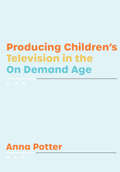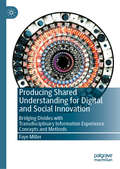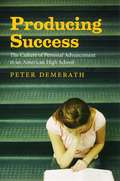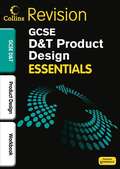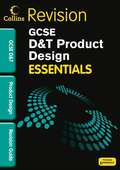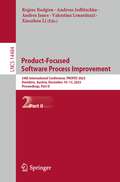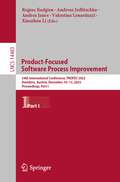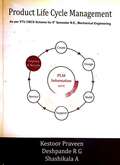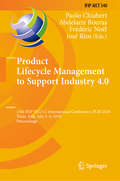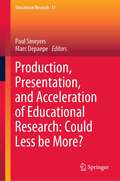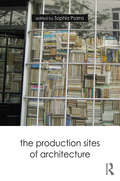- Table View
- List View
Producing Children's Television in the On-demand Age
by Anna PotterChildren’s television is undergoing rapid change. New streaming services like Netflix and YouTube compete with established players like the BBC and Disney. Using interviews with leading screen industry figures, the book examines how practices, funding and production in children’s television are adapting to TV's distribution revolution.
Producing Green Knowledge and Innovation: A Framework for Greening Universities (Innovation, Technology, and Knowledge Management)
by Shantha Indrajith LiyanageThe knowledge and innovation meant for knowledge-based economies (KBEs) are branded as green knowledge and innovation/ethical human capital, blended with the natural system as modeled by the Quintuple Helix Model of Innovation. However, due to bureaucratic challenges and myths, conventional universities produce knowledge and innovation in the sense of traditional disciplinary knowledge, which are not adequate to meet the goals of sustainable development.This book provides a model for greening a university which in turn can produce green knowledge and innovation in the mainstream knowledge production process. This model, which is based on research, can be adopted by the conventional universities in other regions. Such a process results in providing benefits to stakeholders of the university at the micro-level. At the macro-level, it blends with the other knowledge systems—namely, the natural environment of society, economic system, media-based and culture-based public and civil society, and political system—to create a sustainable knowledge economy.
Producing Instructional Systems: Lesson Planning for Individualized and Group Learning Activities
by A. J. RomiszowskiFirst Published in 1986. This two-volume work on the development of instruction is planned as a companion to an earlier book- Designing Instructional Systems. This earlier book dealt with the decision-making process involved in overall course planning and curriculum design. The present continues on to the micro-design stages of lesson and instructional materials development. The work is divided into two volumes. Volume 1, Producing Instructional Systems, deals with lesson planning for individualised instruction in the conventional classroom environment, as well as planning of all group learning situations, simulations and games. Volume 2, Developing Auto-Instructional Materials, deals with the development of many different types of materials, including programmed instruction, structural communication, various styles of structured writing, audio and audio-visual instruction and the many types of computer-based materials now being introduced in both education and training. Taken together, these two volumes give extensive coverage of practical techniques for the development of instruction.
Producing Instructional Systems: Lesson Planning for Individualized and Group Learning Activities
by A. J. RomiszowskiFirst Published in 1986. This two-volume work on the development of instruction is planned as a companion to an earlier book- Designing Instructional Systems. This earlier book dealt with the decision-making process involved in overall course planning and curriculum design. The present continues on to the micro-design stages of lesson and instructional materials development. The work is divided into two volumes. Volume 1, Producing Instructional Systems, deals with lesson planning for individualised instruction in the conventional classroom environment, as well as planning of all group learning situations, simulations and games. Volume 2, Developing Auto-Instructional Materials, deals with the development of many different types of materials, including programmed instruction, structural communication, various styles of structured writing, audio and audio-visual instruction and the many types of computer-based materials now being introduced in both education and training. Taken together, these two volumes give extensive coverage of practical techniques for the development of instruction.
Producing Pleasure in the Contemporary University (Bold Visions in Educational Research)
by Stewart Riddle Marcus K. Harmes Patrick Alan DanaherAcademics working in contemporary universities are experiencing unprecedented and unsustainable pressure in an environment of hyper-performativity, metrics and accountability. From this perspective, the university produces multiple tensions and moments of crises, where it seems that there is limited space left for the intrinsic enjoyment arising from scholarly practices. This book offers a global perspective on how pleasure is central to the endeavours of academics working in the contemporary university, with contributors evaluating the opportunities for the strategic refusal of the quantifying, stultifying and stupefying delimiters of what is possible for academic production. The aim of this book is to open up spaces for conversation, reflection and thought, in order to think, to be and to do differently – pleasurably. Contributors rupture the bounds of what is permissible and possible within their daily lives, habits and practices. As such, this book addresses increasingly significant questions. What are some of the multiple and different ways that we can reclaim pleasure and enhance the durations and intensities of our passions, desires and becomings within the contemporary university? How might these aspirations be realised? What are the spaces for the pleasurable production of research that might be opened up? How might we reconfigure the neoliberal university to be a place of more affect, where desire, laughter and joy join with the work that we seek to undertake and the communities whom we serve?
Producing Shared Understanding for Digital and Social Innovation: Bridging Divides with Transdisciplinary Information Experience Concepts and Methods
by Faye MillerIn the Anthropocene age there is a need for unifying the relationships between people, planet and technology, their interactions, experiences and impacts across ecosystems. In response to this need, this book introduces unifying bridging concepts informational waves and transdisciplinary resonance towards producing shared understanding. This book also presents emerging methods for transdisciplinary projects focusing on moments, paradoxes and dialogues for digital social innovation and sustainable development partnership goals for improving quality of life. Shared understanding is about how people from different fields and perspectives are communicating, curating, embodying, intuiting and reflecting on shared responsibilities within social ecologies. As a guide to co-designing for information experiences that create meaningful moments of shared understanding, the author illuminates essential transferable, lateral mindsets and soft skills: knowing the gaps through imagination, creativity, listening and noticing, and bridging the gaps through problem emergence, multiple stakeholders, informed learning and personal change.
Producing Success: The Culture of Personal Advancement in an American High School
by Peter DemerathMiddle- and upper-middle-class students continue to outpace those from less privileged backgrounds. Most attempts to redress this inequality focus on the issue of access to financial resources, but as Producing Success makes clear, the problem goes beyond mere economics. In this eye-opening study, Peter Demerath examines a typical suburban American high school to explain how some students get ahead. Demerath undertook four years of research at a Midwestern high school to examine the mercilessly competitive culture that drives students to advance. Producing Success reveals the many ways the community’s ideology of achievement plays out: students hone their work ethics and employ various strategies to succeed, from negotiating with teachers to cheating; parents relentlessly push their children while manipulating school policies to help them get ahead; and administrators aid high performers in myriad ways, even naming over forty students “valedictorians.” Yet, as Demerath shows, this unswerving commitment to individual advancement takes its toll, leading to student stress and fatigue, incivility and vandalism, and the alienation of the less successful. Insightful and candid, Producing Success is an often troubling account of the educationally and morally questionable results of the American culture of success.
Producing Success: The Culture of Personal Advancement in an American High School
by Peter DemerathMiddle- and upper-middle-class students continue to outpace those from less privileged backgrounds. Most attempts to redress this inequality focus on the issue of access to financial resources, but as Producing Success makes clear, the problem goes beyond mere economics. In this eye-opening study, Peter Demerath examines a typical suburban American high school to explain how some students get ahead. Demerath undertook four years of research at a Midwestern high school to examine the mercilessly competitive culture that drives students to advance. Producing Success reveals the many ways the community’s ideology of achievement plays out: students hone their work ethics and employ various strategies to succeed, from negotiating with teachers to cheating; parents relentlessly push their children while manipulating school policies to help them get ahead; and administrators aid high performers in myriad ways, even naming over forty students “valedictorians.” Yet, as Demerath shows, this unswerving commitment to individual advancement takes its toll, leading to student stress and fatigue, incivility and vandalism, and the alienation of the less successful. Insightful and candid, Producing Success is an often troubling account of the educationally and morally questionable results of the American culture of success.
Producing Success: The Culture of Personal Advancement in an American High School
by Peter DemerathMiddle- and upper-middle-class students continue to outpace those from less privileged backgrounds. Most attempts to redress this inequality focus on the issue of access to financial resources, but as Producing Success makes clear, the problem goes beyond mere economics. In this eye-opening study, Peter Demerath examines a typical suburban American high school to explain how some students get ahead. Demerath undertook four years of research at a Midwestern high school to examine the mercilessly competitive culture that drives students to advance. Producing Success reveals the many ways the community’s ideology of achievement plays out: students hone their work ethics and employ various strategies to succeed, from negotiating with teachers to cheating; parents relentlessly push their children while manipulating school policies to help them get ahead; and administrators aid high performers in myriad ways, even naming over forty students “valedictorians.” Yet, as Demerath shows, this unswerving commitment to individual advancement takes its toll, leading to student stress and fatigue, incivility and vandalism, and the alienation of the less successful. Insightful and candid, Producing Success is an often troubling account of the educationally and morally questionable results of the American culture of success.
Producing Video For Teaching and Learning: Planning and Collaboration
by Michael O'DonoghueProducing Video for Teaching and Learning: Planning and Collaboration provides lecturers, researchers, professors, and technical staff in educational settings with a framework for producing video resources for teaching and learning purposes. This highly useful guide brings together the literature from the field into a constructive, developmental framework, prompting users to reflect on their own ideas at each stage of the production process. O’Donoghue makes clear distinctions between related aspects of video production, and offers working definitions where appropriate in order to address the academic and tertiary support technical audience. Interviews with established professionals in the field illustrate the possibilities—and limitations—of video for teaching and learning. Producing Video for Teaching and Learning gives readers the power to enhance the learning capacity of their own video materials.
Producing Video For Teaching and Learning: Planning and Collaboration
by Michael O'DonoghueProducing Video for Teaching and Learning: Planning and Collaboration provides lecturers, researchers, professors, and technical staff in educational settings with a framework for producing video resources for teaching and learning purposes. This highly useful guide brings together the literature from the field into a constructive, developmental framework, prompting users to reflect on their own ideas at each stage of the production process. O’Donoghue makes clear distinctions between related aspects of video production, and offers working definitions where appropriate in order to address the academic and tertiary support technical audience. Interviews with established professionals in the field illustrate the possibilities—and limitations—of video for teaching and learning. Producing Video for Teaching and Learning gives readers the power to enhance the learning capacity of their own video materials.
Product Design: Revision Workbook (PDF)
by Ian MacdonaldIntended for use alongside the GCSE Essentials Product Design Revision Guide, this workbook includes further practice questions to test understanding and consolidate understanding. The workbook matches the revision guide page for page for quick and easy reference. Answers are also available.
Product Design: Revision Guide (PDF)
by Brian Russell Ian MacdonaldWritten for 2009 curriculum change, Essentials provides concise coverage of all the externally assessed course content and skills for GCSE Product Design. The student-friendly, uncluttered approach guides students through the core content with succinct revision notes and practice questions that focus on the essential content needed for the exams.
Product Design and Sustainability: Strategies, Tools and Practice
by Jane PentyWhether it is the effects of climate change, the avalanche of electronic and plastic waste or the substandard living and working conditions of billions of our fellow global citizens, our ability to deal with unsustainability will define the twenty-first century. Given that most consumption is mediated through products and services, the critical question for designers is: How can we radically reshape these into tools for sustainable living? As a guide and reference text, Product Design and Sustainability provides design students, practitioners and educators with the breadth and depth needed to integrate the most appropriate sustainable strategies into their practice. It establishes the principles that underpin sustainability and introduces a diverse range of social, economic and environmental design responses and tools available to designers. The numerous real-world examples illustrate how these strategies play out in different product sectors and reinforce the view that sustainability is the most positive opportunity and creative challenge facing designers today. This book: delivers a comprehensive guide to the principles of sustainability and how they apply to product design that can readily be integrated into curricula and design practice reveals many of the issues specific product sectors are facing, and provides the depth and breadth needed for formulating and developing sustainable design strategies to address these issues empowers and inspires designers to engage with sustainability through its many examples and insightful interviews with practitioners is fully illustrated with over 300 photographs, graphs and diagrams and supported by chapter summaries, annotated further reading suggestions, and a glossary.
Product Design and Sustainability: Strategies, Tools and Practice
by Jane PentyWhether it is the effects of climate change, the avalanche of electronic and plastic waste or the substandard living and working conditions of billions of our fellow global citizens, our ability to deal with unsustainability will define the twenty-first century. Given that most consumption is mediated through products and services, the critical question for designers is: How can we radically reshape these into tools for sustainable living? As a guide and reference text, Product Design and Sustainability provides design students, practitioners and educators with the breadth and depth needed to integrate the most appropriate sustainable strategies into their practice. It establishes the principles that underpin sustainability and introduces a diverse range of social, economic and environmental design responses and tools available to designers. The numerous real-world examples illustrate how these strategies play out in different product sectors and reinforce the view that sustainability is the most positive opportunity and creative challenge facing designers today. This book: delivers a comprehensive guide to the principles of sustainability and how they apply to product design that can readily be integrated into curricula and design practice reveals many of the issues specific product sectors are facing, and provides the depth and breadth needed for formulating and developing sustainable design strategies to address these issues empowers and inspires designers to engage with sustainability through its many examples and insightful interviews with practitioners is fully illustrated with over 300 photographs, graphs and diagrams and supported by chapter summaries, annotated further reading suggestions, and a glossary.
Product-Focused Software Process Improvement: 24th International Conference, PROFES 2023, Dornbirn, Austria, December 10–13, 2023, Proceedings, Part II (Lecture Notes in Computer Science #14484)
by Regine Kadgien Andreas Jedlitschka Andrea Janes Valentina Lenarduzzi Xiaozhou LiThis book constitutes the refereed proceedings of the 24th International Conference on Product-Focused Software Process Improvement, PROFES 2023, which took place in Dornbirn, Austria, in December 2023. The 21 full technical papers, 6 industrial papers, 8 short papers and 1 poster paper were carefully reviewed and selected from 82 submissions. The book also contains one tutorial paper, 11 workshop papers and 3 doctoral symposium papers. The contributions were organized in topical sections as follows: Part I: Software development and project management; machine learning and data science; software analysis and tools; software testing and quality assurance; security, vulnerabilities, and human factors; Part II: Posters; Tutorials; 2nd Workshop on Computational Intelligence and Software Engineering (CISE 2023); 2nd Workshop on Engineering Processes and Practices for Quantum Software (PPQS’ 23); doctoral symposium.
Product-Focused Software Process Improvement: 24th International Conference, PROFES 2023, Dornbirn, Austria, December 10–13, 2023, Proceedings, Part I (Lecture Notes in Computer Science #14483)
by Regine Kadgien Andreas Jedlitschka Andrea Janes Valentina Lenarduzzi Xiaozhou LiThis book constitutes the refereed proceedings of the 24th International Conference on Product-Focused Software Process Improvement, PROFES 2023, which took place in Dornbirn, Austria, in December 2023. The 21 full technical papers, 8 short papers, and 1 poster paper presented in this volume were carefully reviewed and selected from 82 submissions. The book also contains one tutorial paper, 12 and workshop papers and 3 doctoral symposium papers.The contributions were organized in topical sections as follows: Part I: Software development and project management; machine learning and data science; software analysis and tools; software testing and quality assurance; security, vulnerabilities, and human factors; Part II: Posters; Tutorials; 2nd Workshop on Computational Intelligence and Software Engineering (CISE 2023); 2nd Workshop on Engineering Processes and Practices for Quantum Software (PPQS’ 23); doctoral symposium.
Product-Focused Software Process Improvement: 23rd International Conference, PROFES 2022, Jyväskylä, Finland, November 21–23, 2022, Proceedings (Lecture Notes in Computer Science #13709)
by Davide Taibi Marco Kuhrmann Tommi Mikkonen Jil Klünder Pekka AbrahamssonThis book constitutes the refereed proceedings of the 23rd International Conference on Product-Focused Software Process Improvement, PROFES 2022, which took place in Jyväskylä, Finland in November 2022.The 24 full technical papers, 9 short papers, and 6 poster papers presented in this volume were carefully reviewed and selected from 75 submissions. The book also contains and 8 doctoral symposium papers and 7 tutorial and workshop papers.The contributions were organized in topical sections as follows: Keynote; Cloud and AI; Empirical Studies; Process Management; Refactoring and Technical Dept; Software Business and Digital Innovation; Testing and Bug Prediction; Posters; Tutorials; Workshop on Engineering Processes and Practices for Quantum Software (PPQS’22); 1st Workshop on Computational Intelligence and Software Engineering (CISE 2022); Doctoral Symposium.
Product Life Cycle Management for 8th Sem B.E Mechanical Engineering
by Kestoor Praveen Deshpande R G Shashikala AProduct Life Cycle Management (PLM) is an elective subject included in the syllabus for 8th semester B.E., Mechanical and allied branches of Visvesvaraya Technological University (VTU), Belagavi, Karnataka. PLM emerged as a new model for companies/organizations to manage their products across their lifecycles, right from the product design and manufacture, to service and disposal of the product. The various strategies and benefits of PLM have made companies to adopt the model in order to support their products and services, and maximize the business impact in global market. This book, in its present form, attempts to give an insight in to the various aspects involved in Product Life Cycle Management. The book is written strictly as per the prescribed VTU Syllabus, also keeping in mind the expectations and needs of the students and the concerned faculties. The book also serves to be useful for students of other courses/branches, while the teaching faculty will find this book a handy reference for teaching.
Product Lifecycle Management to Support Industry 4.0: 15th Ifip Wg 5. 1 International Conference, Plm 2018, Turin, Italy, July 2-4, 2018, Proceedings (IFIP Advances in Information and Communication Technology #540)
by Paolo Chiabert Abdelaziz Bouras Frédéric Noël José RíosThis book constitutes the refereed post-conference proceedings of the 15th IFIP WG 5.1 International Conference on Product Lifecycle Management, PLM 2018, held in Turin, Spain, in July 2018.The 72 revised full papers presented were carefully reviewed and selected from 82 submissions. The papers are organized in the following topical sections: building information modeling; collaborative environments and new product development; PLM for digital factories and cyber physical systems; ontologies and data models; education in the field of industry 4.0; product-service systems and smart products; lean organization for industry 4.0; knowledge management and information sharing; PLM infrastructure and implementation; PLM maturity, implementation and adoption; 3D printing and additive manufacturing; and modular design and products and configuration and change management.
The Production of Heritage: The Politicisation of Architectural Conservation
by Alan Chandler Michela PaceIn this important book, the authors unpack the theoretical and practical issues around the development of heritage sites, critically dissecting key conservation benchmarks such as the ICOMOS guidelines, BS 7913 and the RIBA Conservation Plan of Work to reveal the mechanics of heritage guidance, its advantages and conceptual limitations. Underpinned by an active understanding of the conservation philosophy of William Morris, the book presents five case studies from the UK and North and South America that speak about different facets of heritage value, such as urban identity, commodification, authenticity, materiality and heritage as an intellectual and ethical framework. Heritage is never neutral; its definition is privileged yet its influence is political. Art, landscape and archaeology all offer examples of how the operational ideas of adjacent disciplines can influence an integrated idea of heritage conservation, and how this is communicated in order to determine significance and share in its custodianship. This book provides insights into how to identify and challenge these limitations, expanding inclusion by describing tactics for changing how people can relate to and build on the past. Clearly written for all levels of readership within the conservation professions and community custodians of heritage buildings and places, the book provides strategies and tactics for understanding the heritage significance of materials, their fabrication, detail and use. The narratives that historic fabric contains can help shape the meaningful involvement of local people, providing a roadmap for those navigating the double-bind of using the past to underpin the future.
The Production of Heritage: The Politicisation of Architectural Conservation
by Alan Chandler Michela PaceIn this important book, the authors unpack the theoretical and practical issues around the development of heritage sites, critically dissecting key conservation benchmarks such as the ICOMOS guidelines, BS 7913 and the RIBA Conservation Plan of Work to reveal the mechanics of heritage guidance, its advantages and conceptual limitations. Underpinned by an active understanding of the conservation philosophy of William Morris, the book presents five case studies from the UK and North and South America that speak about different facets of heritage value, such as urban identity, commodification, authenticity, materiality and heritage as an intellectual and ethical framework. Heritage is never neutral; its definition is privileged yet its influence is political. Art, landscape and archaeology all offer examples of how the operational ideas of adjacent disciplines can influence an integrated idea of heritage conservation, and how this is communicated in order to determine significance and share in its custodianship. This book provides insights into how to identify and challenge these limitations, expanding inclusion by describing tactics for changing how people can relate to and build on the past. Clearly written for all levels of readership within the conservation professions and community custodians of heritage buildings and places, the book provides strategies and tactics for understanding the heritage significance of materials, their fabrication, detail and use. The narratives that historic fabric contains can help shape the meaningful involvement of local people, providing a roadmap for those navigating the double-bind of using the past to underpin the future.
Production-oriented and Comprehension-based Grammar Teaching in the Foreign Language Classroom (Second Language Learning and Teaching)
by Anna Mystkowska-Wiertelak Mirosław PawlakThe book addresses one of the key controversies in teaching foreign language grammar, which is the utility of production-oriented instruction, as exemplified in the PPP sequence, and comprehension-based teaching, as implemented in interpretation tasks and processing instruction. It provides a thorough overview of issues related to learning and teaching grammar, with a particular focus on input-oriented approaches, and reports the findings of four studies which sought to compare their effects with instruction based on different forms of output practice. The findings serve as a basis for guidelines on how the two options can be successfully combined in the classroom
Production, Presentation, and Acceleration of Educational Research: Could Less be More? (Educational Research #11)
by Paul Smeyers Marc DepaepeIs educational research chasing the trends one can observe in big sciences, mimicking what happens, some would say successfully, elsewhere in academia? The question in the title of this edited collection took its inspiration from a verse by Goethe: Wer Großes will, muss sich zusammenraffen. In der Beschränkung zeigt sich erst der Meister. Such confinement or limitation that may show mastery does not characterize at all the present state of the educational research publication scene. Instead, there have never been more of such publications which follow each other with an increasing speed. It may therefore be interesting to delve into the reasons of this development that is characteristic of what is published in this field as in many or almost all fields of scholarly work. The chapters in this collection address aspects of the (re)presentation, dissemination and reception, and the production and acceleration of educational research. An international group of scholars, philosophers and historians of education, address questions such as ‘Why publish?’, ‘The lust for academic fame’, ‘Why educational historiography is not an unnecessary luxury?’, and ‘Ways of knowing’. The twelve chapters are preceded by an introduction where issues of plurality and diversity in the study of education are at centre stage and followed by an Epilogue written by the Editors of the Springer Series Educational Research. Paul Smeyers and Marc Depaepe offer some final reflections after a journey of two decades that took them and the colleagues participating in the Research Community from 1999 till 2018 floating on the current of the Zeitgeist that carried the Discipline of Education. They claim finally that mastery in the study of education requires restraint.
The Production Sites of Architecture
by Sophia PsarraThe Production Sites of Architecture examines the intimate link between material sites and meaning. It explores questions such as: how do spatial configurations produce meaning? What are alternative modes of knowledge production? How do these change our understanding of architectural knowledge? Featuring essays from an international range of scholars, the book accepts that everything about the production of architecture has social significance. It focuses on two areas: firstly, relationships of spatial configuration, form, order and classification; secondly, the interaction of architecture and these notions with other areas of knowledge, such as literature, inscriptions, interpretations, and theories of classification, ordering and invention. Moving beyond perspectives which divide architecture into either an aesthetic or practical art, the authors show how buildings are informed by intersections between site and content, space and idea, thought and materiality, architecture and imagination. Presenting illustrated case studies of works by architects and artists including Amale Andraos, Dan Wood, OMA, Koen Deprez and John Soane, The Production Sites of Architecture makes a major contribution to our understanding of architectural theory.
